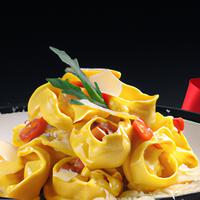
1 serving (100 grams) contains 370 calories, 13.0 grams of protein, 1.5 grams of fat, and 75.0 grams of carbohydrates.

Log this food in SnapCalorie

Nutrition Information
Calories |
740 | ||
|---|---|---|---|
% Daily Value* |
|||
| Total Fat | 3 g | 3% | |
| Saturated Fat | 0.6 g | 3% | |
| Polyunsaturated Fat | 0 g | ||
| Cholesterol | 0 mg | 0% | |
| Sodium | 10 mg | 0% | |
| Total Carbohydrates | 150 g | 54% | |
| Dietary Fiber | 6 g | 21% | |
| Sugars | 4 g | ||
| protein | 26 g | 52% | |
| Vitamin D | 0 mcg | 0% | |
| Calcium | 40 mg | 3% | |
| Iron | 5 mg | 27% | |
| Potassium | 300 mg | 6% | |
* Percent Daily Values are based on a 2,000 calorie diet. Your daily values may be higher or lower depending on your calorie needs.
Food Attributes
Source of Calories
About Pappadelle pasta
Pappardelle is a wide, flat pasta hailing from Italy, traditionally associated with Tuscan cuisine. Made from a simple dough of durum wheat semolina and water, or with the addition of eggs for a richer texture, it is prized for its hearty shape, perfect for holding robust sauces like ragùs and creamy mushroom blends. Nutritionally, pappardelle provides a good source of energy through its carbohydrate content, while egg-based versions also contain a modest amount of protein. Its low fat and sodium levels make it a healthy choice when paired with nutrient-rich toppings like vegetables or lean proteins. However, it’s important to enjoy pappardelle in moderation, as portion control is key to managing calorie intake. For a balanced meal, complement it with fiber-packed veg or a light sauce, and opt for whole wheat versions to boost its fiber and micronutrient profile. Perfect for comforting, hearty meals, pappardelle’s versatility shines in wholesome Italian cooking.



